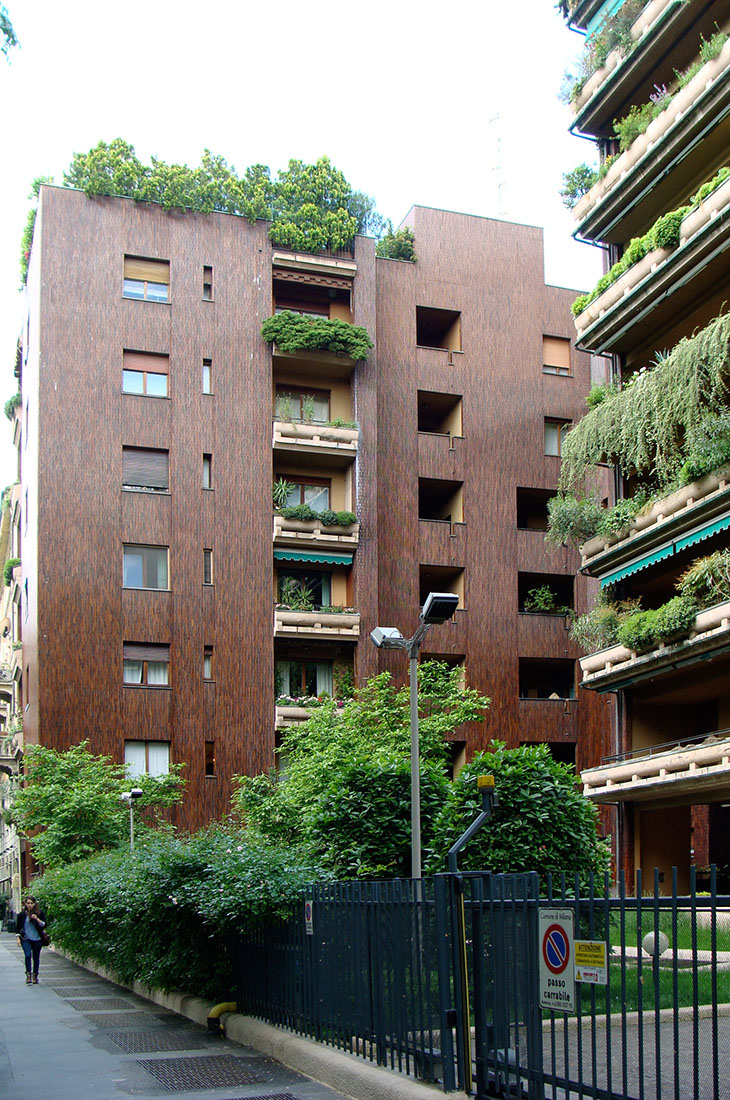 |
 |
 |
 |


Residential Building
Via Tiziano 9, 9a, 11, Milano
1963 - 1968
Luigi
Caccia Dominioni received the commission for this residential complex
in the city of Milan from the family Zucchi in the early 1960s. The
commission asked for
residential and office buildings for the well known textile company. The site for this building ensemble is bordered by the Via Tiziano, Via Veronese and the park of
the Villa Romeo Faccanoni. The urban setting, which was designed by Luigi Caccia Dominioni in separat instances, shows the arrangement of three buildings
forming a C-shape in plan, which is open to the street. The middle volume is considered the main building, and is set back from the street. The main elevation
of this building is dominated by two vertical sequences of large balconies, which consist of plastered concrete. These balconies were originally intended for
offices and residences - today they have becom lush planters. The ground floor of this building is elevated above street level, and the access to the entrance of
the building is made by a ramp in the garden. Low wall elements in soft and rounded forms are arranged along the ramp, and emphasize the continuity with the path.
In the entrance hall, the formal and stylistic language used for the common areas merges with the floor by Francesco Somaini, who often collaborated with
Luigi Caccia Dominioni. The second building, situated directly on the crossroads, follows the shape of the parcel. In its urban setting, it defines the street corner.
In comparision with the main tower, the balconies and windows of this building show a more linear conformation to the volume. The façade of this volume is clad
with two dimensional clinker tiles. The elevation towards the park shows some irregular openings, which are camouflaged within the pattern of the cladding.
The last building works as the termination of the urban setting, and is continously aligned with the street front. This building is connected to the main volume.
This building is distinguised from the two others by the use of a different cladding. Also made of ceramics, the façade of this building is made of three-dimensional
semicircular slats of clinker tiles in a créme caramel colour.
residential and office buildings for the well known textile company. The site for this building ensemble is bordered by the Via Tiziano, Via Veronese and the park of
the Villa Romeo Faccanoni. The urban setting, which was designed by Luigi Caccia Dominioni in separat instances, shows the arrangement of three buildings
forming a C-shape in plan, which is open to the street. The middle volume is considered the main building, and is set back from the street. The main elevation
of this building is dominated by two vertical sequences of large balconies, which consist of plastered concrete. These balconies were originally intended for
offices and residences - today they have becom lush planters. The ground floor of this building is elevated above street level, and the access to the entrance of
the building is made by a ramp in the garden. Low wall elements in soft and rounded forms are arranged along the ramp, and emphasize the continuity with the path.
In the entrance hall, the formal and stylistic language used for the common areas merges with the floor by Francesco Somaini, who often collaborated with
Luigi Caccia Dominioni. The second building, situated directly on the crossroads, follows the shape of the parcel. In its urban setting, it defines the street corner.
In comparision with the main tower, the balconies and windows of this building show a more linear conformation to the volume. The façade of this volume is clad
with two dimensional clinker tiles. The elevation towards the park shows some irregular openings, which are camouflaged within the pattern of the cladding.
The last building works as the termination of the urban setting, and is continously aligned with the street front. This building is connected to the main volume.
This building is distinguised from the two others by the use of a different cladding. Also made of ceramics, the façade of this building is made of three-dimensional
semicircular slats of clinker tiles in a créme caramel colour.